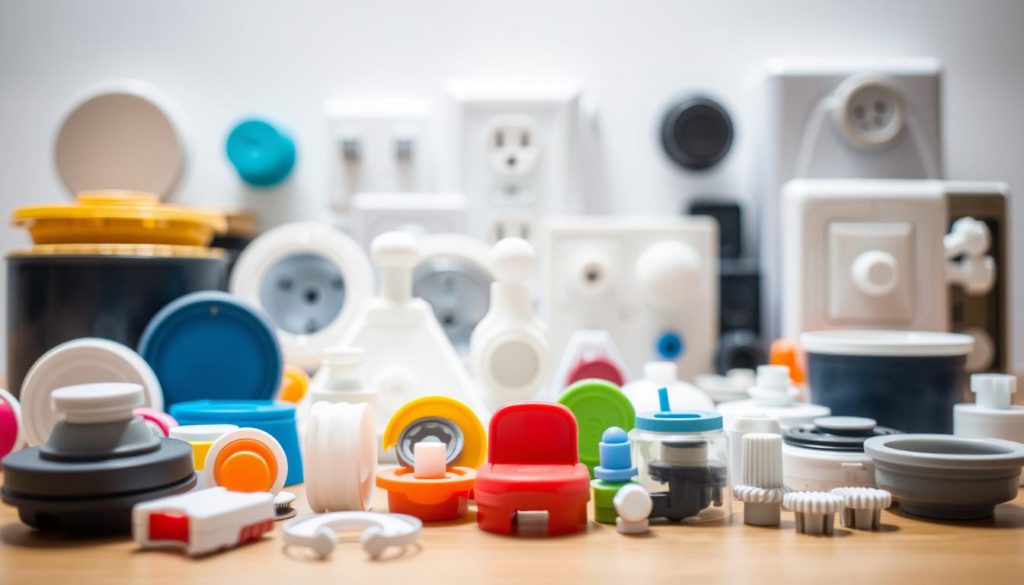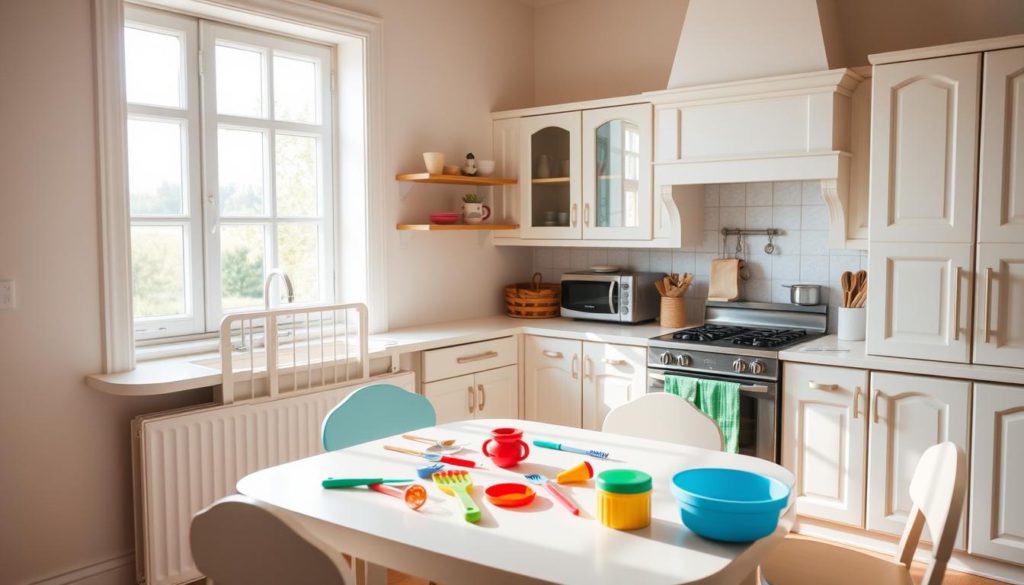Is your kitchen the safest room in your home for your child? Most parents assume so—until they spot their toddler reaching for a hot stove knob or tugging on a dangling appliance cord. The truth is, kitchens hide more dangers than playrooms, from unsecured ovens to cabinets filled with cleaning supplies.
Every year, thousands of kids under five are treated for burns, poisonings, or injuries caused by kitchen hazards. Loose electrical cords, heavy appliances like dishwashers, and unlocked drawers create risks that grow faster than your little one’s curiosity. Even everyday items—like a coffee maker left plugged in—can turn dangerous in seconds.
Child-proofing isn’t just about adding locks or covers. It’s about rethinking how your space works. For example, adhesive cabinet locks from brands like Safety 1st keep cleaning chemicals out of reach, while plastic knob covers prevent tiny hands from turning on stoves. But no gadget replaces your watchful eye—especially during cooking time.
This guide walks you through practical steps to secure your space. You’ll learn how to install drawer latches, stabilize top-heavy ovens, and create zones where your child can explore safely. Let’s turn your kitchen from a hazard zone into a haven.
Key Takeaways
- Kids spend 60% of their time at home in shared spaces like kitchens, according to safety studies.
- Unplug small appliances like toasters when not in use to prevent electrical accidents.
- Use magnetic locks for lower cabinets and heat-resistant covers for stove knobs.
- Burns from stoves and tip-overs from dishwashers are leading causes of kitchen injuries.
- Supervision matters—safety tools work best when paired with active monitoring.
- Brands like Dreambaby offer durable solutions for securing drawers and ovens.
Understanding the Risks in Your Kitchen

Kitchens blend functionality with hidden perils—especially when curious little explorers are involved. Nearly 40% of home injuries in children under five occur in this space, according to the National Safety Council. Let’s break down where dangers lurk.
Hot Zones and Heavy Hazards
Stoves and ovens top the risk list. A toddler’s grip on a hot oven door can cause severe burns in seconds. Dishwashers pose dual threats: sharp utensils inside and tipping risks if not anchored. Even refrigerators become dangerous when little ones climb open drawers to reach snacks.
Everyday Items Turned Dangerous
Lower cabinets storing cleaning supplies invite trouble—93% of poison control cases involve products kept under counters. Loose appliance cords dangle like tempting ropes, while unsecured trash cans hide choking hazards. Common oversight: Items near counter edges. A coffee mug left too close could crash down during playtime.
- Electrical shocks spike when toasters or blenders remain plugged in
- Drawers with knives or graters cause 15% of kitchen cuts annually
- Oven knob covers reduce burn risks by 72%, per safety studies
Toddlers spend 6+ hours daily in shared home spaces. Their knack for climbing and pulling transforms ordinary objects into threats. By spotting these risks early, you’ll craft smarter solutions—like magnetic locks for cabinets or anti-tip brackets for heavy appliances.
How to Child-Proof Your Kitchen Appliances

Securing your space starts with strategic hardware choices that balance accessibility and protection. Let’s explore two critical upgrades that keep curious hands away from danger while letting adults maintain full functionality.
Cabinet Security Made Simple
Adhesive magnetic locks like Safety 1st’s model at Target take three minutes to install. Clean the surface, apply the adhesive strips, and align the magnetic key for smooth operation. These let you open cabinets with one hand while blocking access to cleaning supplies or sharp tools.
For drawers holding knives, use metal safety latches. Dreambaby’s stainless steel version withstands tugging while allowing a 2-inch gap for adult access. Test each latch after installation—if your child can wiggle it open, reinforce with extra screws.
Heat Prevention Tactics
Stove knob covers like Mom’s Choice Awards winner Protect-A-Knob snap over controls without adhesives. Their heat-resistant plastic withstands 400°F, and the rotating design requires adult-level grip strength. For ovens, choose silicone covers that stretch around handles—they block direct contact but peel off easily when baking.
Always unplug microwaves and dishwashers after use. As one safety expert notes: “Power cords are silent risks—remove their threat entirely during downtime.” Pair these steps with appliance latches that prevent door openings but release instantly with a button press.
Tips for Creating a Child-Safe Cooking Environment

Transforming your cooking space into a family-friendly zone requires more than just locks—it demands smart habits. Start by establishing clear zones: keep kids at least three feet from active cooking areas using baby gates or visual markers like colored floor mats.
Smart Cooking Habits Save Lives
Always use back burners when possible, and turn pot handles inward to prevent accidental spills. A 2023 Johns Hopkins study found this simple step reduces scalding injuries by 68%. Keep hot beverages away from counter edges, and never leave cooking food unattended—even for 10 seconds.
- Assign a “safe spot” like a highchair with toys during meal prep
- Store oven mitts and trivets in locked drawers after use
- Install smoke detectors within 10 feet of cooking appliances
Strategic Storage Solutions
Move cleaning supplies to upper cabinets secured with magnetic locks. For knives, use drawer inserts with sliding covers or wall-mounted racks above counter height. As one pediatric safety specialist advises: “If you can reach it without stretching, so can your toddler.”
Anti-tip brackets are essential for ovens and dishwashers. Brands like Safety Innovations offer renter-friendly models that clip on without drilling. Test all safety latches monthly—toddlers develop new skills faster than you’d expect.
While these steps help, remember: no gadget replaces active supervision. Combine physical barriers with constant awareness to build true protection. Your upgraded space will feel calmer and more controlled—for both of you.
Conclusion
A safe kitchen environment blends proactive measures with ongoing vigilance. Installing magnetic locks, knob covers, and appliance latches forms your core defense against hazards. Brands like Safety 1st and Dreambaby offer reliable tools that adapt as your child grows—but these work best when paired with consistent supervision.
Regularly reassess risks like unsecured drawers or accessible appliance cords. Test anti-tip brackets monthly and replace worn safety devices promptly. Small upgrades, like heat-resistant stove covers or sliding drawer shields, make big differences in daily safety.
Remember: no gadget replaces your presence. Combine secured appliances with habits like using back burners and storing cleaners up high. This dual approach creates a functional space where meals and memories unfold safely.
Start today by reviewing one high-risk area—perhaps anchoring heavy appliances or relocating knives. Each step builds confidence, ensuring your kitchen remains the heart of your home without compromising safety. Peace of mind begins with action.
FAQ
What kitchen areas pose the highest risks to young children?
Ovens, stoves, and dishwashers are top hazards due to heat, sharp edges, or moving parts. Lower cabinets with cleaning supplies or utensils also rank high. Always secure these zones first.
How do I keep toddlers from turning stove knobs?
Install heat-resistant knob covers like those from Safety 1st or Dreambaby. These lock onto gas or electric range knobs, preventing accidental activation while cooking.
Can I child-proof refrigerator doors effectively?
Yes. Magnetic locks like the Adhesive Refrigerator Lock by Dreambaby work on most models. For French-door styles, consider dual-point latches to block access to both sides.
Which everyday kitchen items often get overlooked as dangers?
Dishwasher pods, spice jars, and small appliances like toasters or blenders attract curiosity. Store pods in locked cabinets, secure cords, and use appliance latches for heavy gear.
What’s the safest way to block access to knife drawers?
Use interior drawer latches like the Safety Innovations Multi-Purpose Locks. They install inside the drawer frame, keeping sharp tools hidden but accessible to adults.
Are stove guards necessary for gas ranges?
Guards like the Summer Infant Secure Safety Gate create a physical barrier. Pair them with knob covers for layered protection against burns or gas leaks.
How can I maintain a safe cooking zone with kids nearby?
Designate a “no-go area” using baby gates during meal prep. Keep pots on rear burners, and use back-handed stirring to avoid spills. Never leave cooking unattended.
Where should cleaning supplies be stored in a child-proofed kitchen?
Place them in upper cabinets secured with magnetic locks. Avoid under-sink storage unless using a double-latch system like the Mommy’s Helper Push ‘N Snap.
